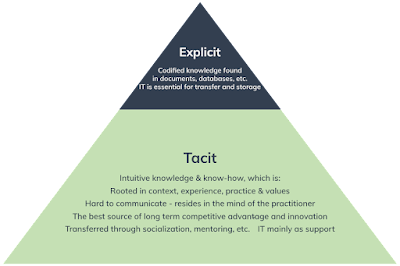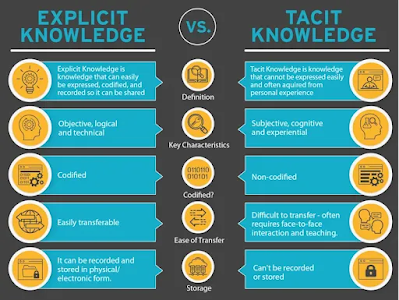"Unveiling the Dynamics: Navigating Tacit and Explicit Knowledge in Contemporary Contexts"
The
differentiation between tacit and explicit knowledge stands as a crucial
element in the realm of Human Resource Management (HRM), shaping how organizations
handle and capitalize on their intellectual assets. Informed by insights from
foundational works in HRM literature, this discussion delves into the intricate
dimensions of tacit and explicit knowledge, acknowledging their significance in
organizational learning, performance, and the strategic utilization of human
resources.
In the context of Human Resource Management (HRM), tacit and explicit knowledge refer to two types of knowledge that employees possess within an organization.
Tacit Knowledge:
- Tacit knowledge is the kind of knowledge that is difficult to express or transfer through formal documentation or communication. It is deeply rooted in an individual's experience, insights, and intuition.
Explicit Knowledge:
- Explicit knowledge is formal and codified information that can be easily documented, communicated, and shared. It is tangible and can be expressed in words and numbers.
In HRM, a balance between tacit and explicit knowledge is crucial. While explicit knowledge provides a foundation for standardization and efficiency, tacit knowledge is invaluable for handling unique situations, fostering innovation, and promoting a deeper understanding of human behavior within the workplace. Effective HRM often involves creating mechanisms for capturing, sharing, and leveraging both tacit and explicit knowledge to enhance organizational performance and adaptability.
Tacit
knowledge, elucidated by Chen, Liaw, and Lee (2003), refers to the intuitive,
experiential, and often unspoken knowledge residing within individuals. Rooted
in personal experiences, insights, and understandings, tacit knowledge holds
particular relevance in HRM concerning employee skill sets, problem-solving
abilities, and innovative capacities (Katou & Budhwar, 2010). Wan-Jing and
Tung's (2005) emphasis on the correlation between strategic human resource
management and firm performance aligns with the idea that tacit knowledge forms
a valuable resource for organizations seeking a competitive advantage through
their workforce.
In
contrast, explicit knowledge is codified, documented, and easily transferable
through formal channels (Nonaka & Takeuchi, 1995). Tangible and conveyable
through manuals, procedures, databases, and other formalized structures,
explicit knowledge is foundational to structured training programs and contributes
to the development of a shared understanding of practices and processes within
an organization (Chen et al., 2003).
The
effective management of tacit and explicit knowledge is pivotal to
organizational learning, as highlighted by Boxall and Purcell (2003) in the
strategic dimensions of HRM. Aligning human resource practices with broader
organizational strategies becomes paramount, wherein tacit knowledge becomes a
strategic reservoir that enhances organizational performance and adaptability
(Wan-Jing & Tung, 2005).
Moreover,
the integration of tacit and explicit knowledge with the psychological
contract, as explored by Guest (1991), underscores their impact on the
employment relationship. Tacit knowledge contributes to the social and
relational aspects of the psychological contract, fostering trust and
commitment between employees and the organization. Explicit knowledge plays a
role in the contractual and transactional elements, providing a clear framework
of expectations and responsibilities.
Nevertheless,
challenges emerge in the effective management of tacit and explicit knowledge.
Guest and Conway (2004) highlight potential barriers in the dissemination of
tacit knowledge, emphasizing the need for an organizational culture that
encourages knowledge sharing. Additionally, the limitations of over-relying on
explicit knowledge, as discussed by Paauwe (2009), underscore the importance of
recognizing the dynamic interplay between tacit and explicit knowledge in
fostering a holistic approach to organizational learning.
References
Chen,
Liaw, & Lee. (2003). Using an HRM pattern approach to examine the
productivity of manufacturing firms - An empirical study. International
Journal of Manpower, 24(3), 299–318.
.jpeg)


Knowledge as an iceberg model is a un common topic choice .thank you very much for explain the content in a artistic manner in detail with tacit Knowledge, explicit Knowledge with examples The eye catching manner of this post is remarkable because human knowledge drives successful management process for an organization
ReplyDeletemost welcome for your valuable comments. Thanks
DeleteExcellent and very exciting ! This blog astutely explores the interplay between tacit and explicit knowledge in contemporary contexts, shedding light on their strategic implications. At an MBA level, comprehending this distinction is crucial for future business leaders, as it allows them to leverage both forms of knowledge to drive innovation, foster a learning culture, and facilitate knowledge sharing within organizations. Understanding the dynamics between tacit and explicit knowledge equips leaders with the acumen to navigate complexities, adapt to change, and capitalize on organizational knowledge assets, ultimately driving sustained success in today's dynamic business landscapes.
ReplyDeleteThank you https://draft.blogger.com/profile/10856071426375222547
DeleteA good blog.very attractive. Grabbed a good knowledge on Tacit and Implicit knowledge. It gives dynamics of such knowledge base.
ReplyDeleteAppreciate the attempt made for finding as this is not a common area in discussed.
Thank you
DeleteThis is an insightful exploration of tacit and explicit knowledge in HRM adeptly differentiates their roles, emphasizing their impact on organizational learning. Drawing on HR literature, the article stresses the need for a balanced approach, integrating personal insights with formalized information. The blog highlights the challenges and solutions in managing these knowledge types for organizational success
ReplyDeleteThank you.
DeleteThis is a very attractive topic to discuss in the current HR context. A new knowledge area for me. Well explained and written. Explicit knowledge is information that can be easily articulated and documented, while tacit knowledge is the unspoken, experiential know-how that is challenging to express formally.
ReplyDeleteThank you!
Delete